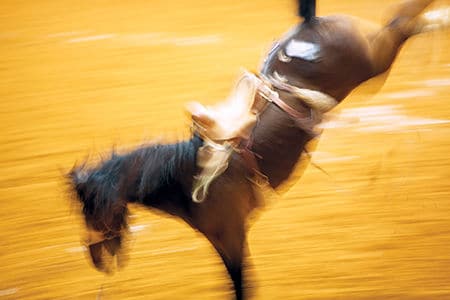Rodeo: Photographs by Rima Canaan Lee
On display through Feb. 7
Admission is $10, $8 for children 3-12 and adults 60-plus
National Cowgirl Museum and Hall of Fame
1720 Gendy St.
Fort Worth
817-476-3263
www.cowgirl.net
As the city prepares for the 120th Fort Worth Stock Show & Rodeo at the Will Rogers Complex, a new exhibit at the National Cowgirl Museum and Hall of Fame invites us to take a fresh look at the rodeo and livestock-raising culture that will be on display next door.
“Rodeo: Photographs by Rima Canaan Lee,” which opened Nov. 20 and runs through Feb. 7, gathers 18 works by a photographer who turned her lens on one of Fort Worth’s biggest and most signature events.
Lee attended the 2013 Stock Show almost every day, making photographs as she watched the rodeo action and visited the livestock barns. The result is two distinct sets of images, one depicting rodeo performers (animal and human) and one focusing on the children and teens competing in the livestock events.
The rodeo works are smears of motion that seem almost painting-like. “I tried to capture in a single image some essence of speed and energy,” Lee says in her artist’s statement.
She describes images such as Two Riders as “motion-blurred portraits that camouflage identity while emphasizing immediacy. As I photographed the action, I could see the images become almost abstractions in which the golden dirt appeared to carry the promise, triumphs, and defeats of the rodeo narrative.”
In her Stock Show works, “The young people dressed as boys might have in 1896, the year of the first show, in plaid shirts, cowboy hats, and cowboy boots, yet the iPhones they all carried updated the images to 2013. … I felt that I was photographing a social phenomenon, a stock-show tradition from the 19th century as it intersects with the Internet age.”
Diana Vela, the Cowgirl Museum’s associate executive director for exhibits and education, says Lee, who was born in Beirut and raised in Germany, “did not grow up with a rodeo or stock show tradition, making her a great candidate for a fresh perspective on the subject.”
Many of us walk through the barns with blinders on, used to seeing scenes like this and therefore not really “seeing” in a conscious way.
But, says Vela, “Lee’s photography stops us in a moment in time and really allows us to focus on that one student who has undoubtedly put in hours upon hours of work and care and money to be here. What expressions do they wear? What might they be thinking? What are they doing? How are they dressed? What is around them?”
Before she moved to Fort Worth, Lee knew rodeo culture the way people around the world know it, from literature and films selling “narratives of rugged individualism, pioneering spirit, unapologetic machismo, and, above all, freedom,” she writes.
In photographing our rodeo, she found “an event that is very much alive, youthful, and in stride with contemporary society, an event that still carries the promise of the Old West.”






